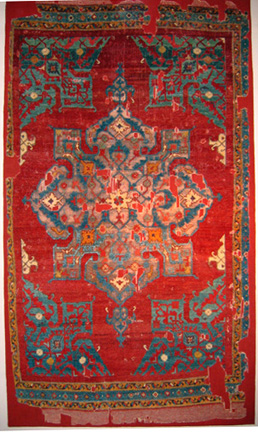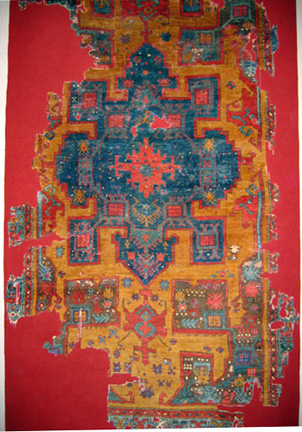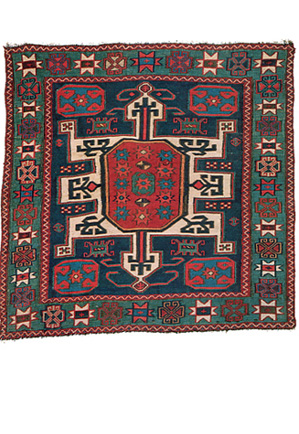Posted by Wendel Swan on 06-20-2007 06:05 PM:
Whence the beetle bag
Dear all,
With 700 continuous years of weaving tradition on display at
the TIEM at one time, it is a wonderful place to learn about carpets and the
vast tradition that they represent. It is also allows us to place more recent
collectibles into their historical context.
For a long, long time I would
periodically mull over the possible origin of the so-called “beetle bags”,
always convinced that they could not represent beetles or any other animate
object. I superimposed drawings of Holbein interlaces on them and thought I was
close, but there was never a nexus in the wool.
Quite a few years ago I
saw an image of an early Ushak-type rug with 8 lobes that convinced me it was in
the design continuum that produced the beetle bags. Somehow I lost that image
but at the TIEM in April I saw the rug itself.
On the left is a 17th
Century Ushak star medallion carpet (of exceptional quality) in the TIEM
collection and in the middle is the 17th or 18th Century version from Cappadocia
that I had remembered. On the right is the beetle bag from the cover of
FTBTS.



Of course, there is a 200
year gap between the Cappadocia rug and the beetle bag, but to me it is not at
all difficult to see the progressive changes continuing into the bag, down to
the inclusion of the four boxes surrounding the medallion. There are many
similarities in designs between traditional Anatolian rugs and Caucasian rugs
and I believe that this is yet another.
I cannot say that this Cappadocia
rug in the TIEM is itself the ancestor of beetle bags, but others like it must
have existed and must have been copied. My earlier Holbein interlace theory may
still has some merit, but the Cappadocia rug at the TIEM makes a rather
convincing argument.
Wendel
Posted by Filiberto Boncompagni on 06-21-2007 03:59 AM:
Hi Wendel,
Absolutely.
The more we look into the matter, the more
we find supposedly “tribal” designs coming from city rugs.
How unromantic.

Regards,
Filiberto
Posted by Marty Grove on 06-21-2007 08:38 AM:
City vs Tribal
G'day Wendel and Filiberto,
Those three which you show Wendel, very
definitely are connected through time. What surprises me is - forgive me
Filiberto if I am taking a liberty or mistakenly believe you are intimating the
earlier two are city rugs - but how can one say the Cappodocia and the Ushak
were city products?
You havent said that Filiberto, but I take it that
you surmise these two to be city rugs. From my just looking at the pictures, and
reading that the Ushak is a very fine piece, there still is nothing to indicate
to me that they were woven in a city or otherwise.
While I accept the
likelihood that transference of design passed from city to bush and visa versa,
looking at these old rugs does not really give me any sign just what sort they
are.
Is there something specific which might lead us to identify the
first two are from the city?
Respectfully,
Marty.
Posted by Filiberto Boncompagni on 06-21-2007 08:52 AM:
Hi Marty,
I'm not sure about the Cappadocian one (probably not), but
the Ushak IS a city carpet:
Ushak carpet - floor covering handwoven in the
city of Usak (Ushak), Turkey. By the 16th century the principal manufacture of
large commercial carpets in Ottoman Turkey had been established at Usak, which
produced rugs for palace and mosque use and for export. In the 18th and early
19th centuries, this manufacture came increasingly under European
control.
from http://www.britannica.com/eb/article-9074517/Ushak-carpet
Regards,
Filiberto
Posted by Marty Grove on 06-21-2007 09:32 AM:
Aah, Thanks Filiberto,
Excellent, that clears that up - I must admit
not having travelled to Turkey, and being only generally aware of the specific
cities, familiarity of the two places is not exact.
While I have read a
fair bit about the weavings of Turkey and some of the historical contexts, this
city versus tribal question has always left me a bit adrift.
When I think
of city carpets, I see in my mind a large place with lots of looms and weavers
working on the well ordered manufacture of very ornate, often large type
carpets.
What is harder to get my mind around is the idea that if we
accept that carpet making is thousands of years old, and a continuence
throughout that time of girls being trained to weave them, why not can we then
also presume that a percentage of these weavers whether working in the bush or
city, are capable of extremely fine intricate work using exceptional materials,
good wool and fantastic dyes.
It doesnt necessarily follow that this
first class weaver, say a lady from the bush, will gravitate to the city to
weave the masterworks drawn by some famous 'cartoonist'.
A well known
master weaver would be an asset not only to her family but also to her village
and she may not wish to leave that little village where her life is content, and
so might produce in that little village of 40 or 50 persons just such masterful
weavings that are so remarked on and desired today.
I find it hard to
accept that all very fine and detailed intricate rugs were essentially city
products. Even if certain designs are known to be mainly the work of specific
city workshops, is there any reason why the renowned weaver in the little place
way outback might not weave her own version which may be indistinguishable from
the more common 'city' one?
Its semantics I know, splitting hairs, and
apols if it seems Im being argumentative, but I just think this divide 'twixt
city and bush is not really so definitive. While its true some of us prefer one
or the other, I dont really think we can always
tell...
Regards,
Marty.
Posted by Marty Grove on 06-21-2007 09:53 AM:
Ouch
Filiberto, bang, shot myself in the foot in my last post, realising that the
operative word is 'large', and as you showed, the Ushak were large carpets which
obviously were highly unlikely to have been woven at home by however excellent
the weaver.
She probably just would not have the size loom, nor the
resource capability to make something so big.
I guess that tribal, using
the word to indicate NOT city, really can be applied more often only to fairly
small pieces, regardless how ornate, fine and
intricate.
Regards,
Marty.
Posted by Wendel Swan on 06-21-2007 10:10 AM:
Hi Marty,
The terms city, village and nomadic are all relative terms
that refer to a combination of aspects of a rug. When we refer to a city rug we
refer to its style, the size, the regularity of the weave, the structure, its
intended use, the number of similar rugs produced and whether the rug appears to
have been woven under supervision or by following a cartoon.
Ushak was an
important and influential weaving center that produced huge quantities of rugs
over a long period of time. The large star and medallion Ushaks are perhaps the
most readily identifiable, but small rugs were also woven in Ushak or its
environs, including a yastik that I own and appears in this thread posted by
Jeff Krauss:
http://www.turkotek.com/VB22/showthread.php?s=&threadid=3014
The
Ushak on the left is what I think anyone would call a city rug, being
sophisticated in drawing and execution and of good size. It must have been woven
on a fixed loom and under supervision.
Because of its size alone, the
Seljuk carpet that appears in the “legacy” thread was also undoubtedly woven in
an urban environment, but proper supervision appears to have been wanting, in
either setting up the loom or in the actual weaving.
The Cappadocia rug
above is less formally drawn and executed and its style is derivative, so we’re
tempted to call it village. But it could have been woven in a city, as Filiberto
suggests. Some small towns or villages produced lots of rugs and many large
cities produced few if any.
So, city and village are relative, not
absolute, terms.
Wendel
Posted by R. John Howe on 06-21-2007 10:18 AM:
Dear folks -
Not to detract from Wendel's initial taxonomy (which
seems to me to show striking similarities), and not to follow precisely Marty's
question of whether the older rugs with more complex designs are properly
described as "city rugs," there is a related old debate about whether there are
designs that originated in more remote sectors of rug producing societies, these
latter being described as "nomadic," "tribal," maybe even "village," as
contrasted with designs that seem to have originated in more "urban"
settings.
The old debate is usually about which direction of "flow" is
properly seen to be predominant. Some say from the country-side to the urban
areas. Others say that most designs originate in urban areas and moved to the
countryside. There are even some who seem not to worry about flow, but who say
that particular designs originated in both of these places.
Murray
Eiland, Jr. has for years argued that he thinks it unlikely that designs
credited to nomads originated in such societies. He believes that most designs
originated in urban settings and moved to the countryside. Lots of folks seem
nowadays to agree with him.
But Michael Franses has recently argued in
print that he believes that the nomads who came into such areas as northwest
Turkey already had designs of their own when they first contacted urban areas
and so the designs in their pieces were/are not strictly products of urban
influence.
I was surprised to see him make this argument because I had
the impression that the Eiland thesis was now pretty generally
accepted.
Apparently not in some circles.
Regards,
R. John
Howe
Posted by Marty Grove on 06-21-2007 11:05 AM:
Possibilities
Thanks Wendel, Filiberto and John,
You have each deliniated an
acceptable picture of the three main groupings from within which rugs were made.
I accept the main suppositions between city, village and nomad are pretty
straight forward as you have explained.
John has given more food for
thought, and following it, might there be the possibility the 'beetle bag'
displayed by Wendel was the originator of the previous two pieces?
With
an influx of other weaving groups into Turkey at some time in the past, bringing
with them their own designs, its not beyond the realm of possibility some clever
designer saw the 'beetle' type and thought 'Now thats something different - if I
embellish it somewhat, from the cubic geometric to a more rounded style, it may
prove popular with my urban clients'.
By the nature of weavings past and
present, there is endless stuff for speculation, and this probably is another
facet of just why we love such things as we do.
Regards,
Marty.
Posted by Horst Nitz on 06-21-2007 06:00 PM:
Hi Folks,
Wendel, your introductory comment was right from my heart
and right as right could be (sic!).
Sixteenth century at last saw the
Ottomans taking control over the east of Turkey, which until not much earlier
was ruled by the Akkoyunlu, based in West-Persia. Eastern Turkey and Western
Persia were a cultural and political entity for many centuries. The early "Usak"
rugs come from there. The manufacture in Usak in the west of the country, put up
by the Ottomans in 16th century, continued / exploited earlier designs from the
east.
It is not surprising that the "beetle"-motiv is showing on the
cover of FTBTS (an IQ of 170  was helpful in figuring out what you were referring to by this): the Shasavan as
the probable originators of bags like the one further up, inherited and
processed a motiv that was put into the region's pool a considerable time before
they were formed; in this way the city version from Usak was just another
interpretation but by no means the original.
was helpful in figuring out what you were referring to by this): the Shasavan as
the probable originators of bags like the one further up, inherited and
processed a motiv that was put into the region's pool a considerable time before
they were formed; in this way the city version from Usak was just another
interpretation but by no means the original.
I know this is not a
mainstream view, but on the other hand there is something like evolution of
concepts: those "beetle"-bags, at the time of the exhibition and when the book
was printed in 1969, were still thought of as being
Caucasian.
Bye,
Horst




 was helpful in figuring out what you were referring to by this): the Shasavan as
the probable originators of bags like the one further up, inherited and
processed a motiv that was put into the region's pool a considerable time before
they were formed; in this way the city version from Usak was just another
interpretation but by no means the original.
was helpful in figuring out what you were referring to by this): the Shasavan as
the probable originators of bags like the one further up, inherited and
processed a motiv that was put into the region's pool a considerable time before
they were formed; in this way the city version from Usak was just another
interpretation but by no means the original.